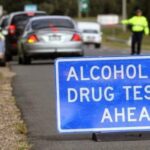Police Officer Sent to Prison Over Fatal Collision

An officer who crashed while speeding to a non-urgent call killing a man and leaving his wife with permanent injuries has been sentenced to three years in prison.
Former Tasmanian police officer, Aaron Bonner, was responding to a non-urgent call in central Launceston on 6 January 2020 when he sped through a red light and collided with another car, sending his vehicle out of control.
The police vehicle mounted the kerb, killing New South Wales man Anthony Robert Campbell and severely injuring his wife Bernice who were walking along the footpath.
Fatal crash
The court heard that the officer was travelling at 89km/h in a 50km/h zone when he ran through the red light.
He had engaged his vehicle’s emergency lights but only activated the siren briefly, making it difficult for other vehicles to detect the oncoming danger.
Mrs Campbell suffered a broken pelvis and nerve damage, and was left in a coma for a week.
She spent two months in hospital, later having to use a wheelchair. She now walks with the use of a cane and was found to have suffered permanent physical as well as psychological injuries.
The officer pleaded guilty to the offences of dangerous driving occasioning death and dangerous driving occasioning grievous bodily harm.
Victim impact statement
In her victim impact statement, Mrs Campbell told the court:
“My life and my body were smashed to pieces”
“I can’t adequately describe the anguish I felt when I was wheeled up to his coffin.”
She added that she harbours no animosity towards the defendant, saying “I think perhaps I’ve forgiven you,” she said.
“I am confident you set out with no intent to harm us. I know you must also struggle with massive guilt.”
Three years’ imprisonment
During the sentencing proceedings, the presiding judge told the defendant, “I am satisfied that you are and have been since these events overcome by remorse and are intensely aware of the impact of your actions”.
He was sentenced to three years behind bars and will not be eligible to apply for release on parole until he has served half of his sentence.
He has also been disqualified from driving for two years, a term scheduled to commence upon his release from custody.
The offence of dangerous driving occasioning death in New South Wales
Dangerous driving occasioning death is an offence under section 52A(1) of the Crimes Act 1900 which carries a maximum penalty of 10 years in prison.
To establish the offence, the prosecution must prove beyond reasonable doubt that:
- You were the driver of a motor vehicle,
- You were involved in an impact causing the death of another person, and
- You were under the influence of alcohol or a drug, or you were driving at a dangerous speed, or you were driving in a dangerous manner.
A ‘vehicle’ is defined as:
- Any motor car, motor carriage, motor cycle, or any other vehicle propelled, wholly or partly, by volatile spirit, steam, gas, oil, electricity, or by any other means other than human or animal power, or
- A horse-drawn vehicle.
An ‘impact’ is that which occurs:
- between an object or a person and the vehicle,
- between an object, including the ground, due to being thrown from the vehicle,
- with another vehicle or object in, on or near a person,
- with anything on or attached to the vehicle,
- with anything in motion through falling from the vehicle.
It also includes where:
- A vehicle overturns or leaves the road, or
- A person falls or is thrown or ejected from the vehicle.
Under section 52A(2), the maximum penalty increases to 14 years in prison where the offence is committed in ‘circumstances of aggravation’ which is where:
- You had a ‘prescribed concentration of alcohol’ in your bloodstream,
- You exceeded the speed limit by more than 45 km/h, or
- You were ‘very substantially impaired’ by a drug or drugs.
A ‘prescribed concentration of alcohol’ is a reading of at least 0.15.
You are presumed to have been under the influence of alcohol where you had the prescribed concentration of alcohol in your bloodstream.
A certificate of your alcohol or drug concentration is admissible as evidence as long as the analysis occurred within 2 hours after the impact, unless you are able to prove ‘on the balance of probabilities’ that the concentration was lower at the time impact.
A defence to the charge is that the death was not attributable in any way to:
- Being under the influence of alcohol or drugs,
- The speed at which you drove, or
- The manner in which you drove.
The offence of dangerous driving occasioning grievous bodily harm in New South Wales
Dangerous driving occasioning grievous bodily harm is an offence under Section 52A(3) of the Crimes Act 1900 which carries a maximum penalty of 7 years in prison.
To establish the offence, the prosecution must prove beyond reasonable doubt that:
- You were the driver of a motor vehicle,
- You were involved in an impact that caused grievous bodily harm (GBH) to another, and
- You were under the influence of alcohol or drugs, or you were driving at a dangerous speed, or you were driving in a dangerous manner.
‘Grievous bodily harm’ is defined by the courts as ‘very serious harm’. This includes but is not limited to:
- Any permanent or serious disfigurement,
- The destruction of a foetus, other than by a medical procedure, and
- Any grievous bodily disease.
Under section 52A(4), The maximum penalty increases to 11 years in prison where the offence is committed in any ‘circumstance of aggravation’ outlined above.
Going to court for a traffic offence?
If you are going to court for a traffic offence, call or email Sydney Criminal Lawyers anytime to arrange a free first consultation with an experienced, specialist traffic lawyer who will accurately advise you of your options, the best way forward, and fight for the optimal outcome in your specific situation.








